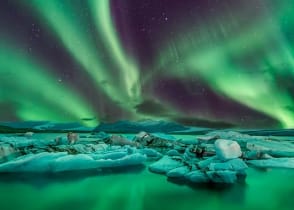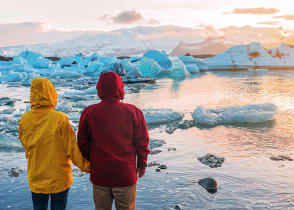Best Time to Visit Iceland
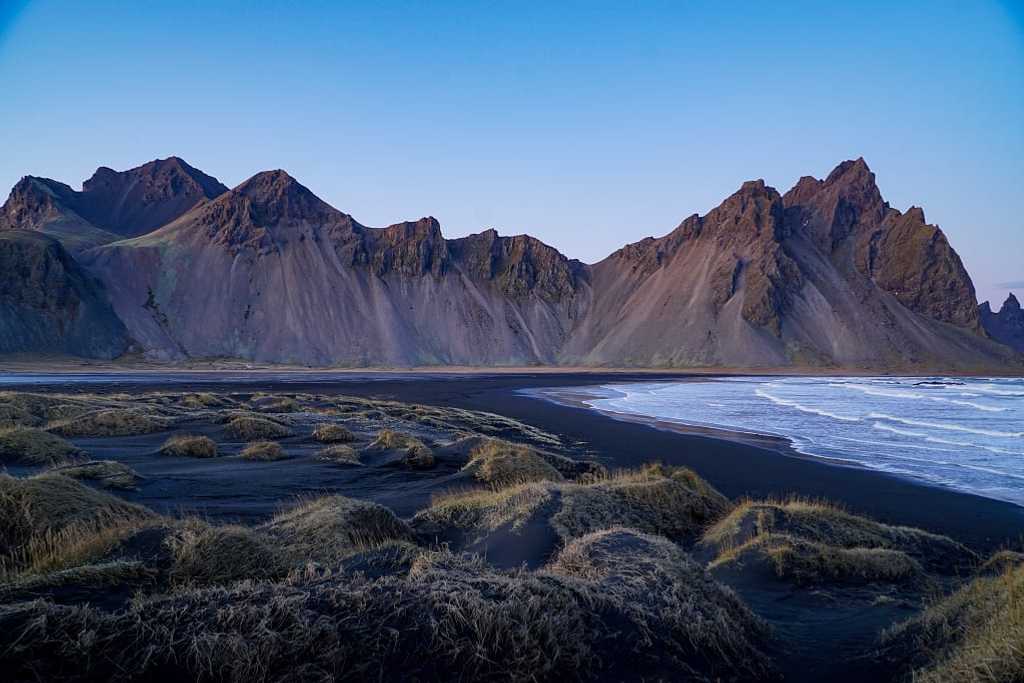
Vestrahorn mountain range and Stokksnes beach in Iceland
An island of mystique and majesty, the best time to visit Iceland shines a light on the intense glaciers and black basalt beaches, culturally rich towns and soothing thermal baths.
Iceland is familiar and unpredictable, only enhancing the dramatic ambiance from the coastline to the highlands.
Whether you are looking for distinctive cuisine, a cultural experience, or an immersive exploration of the epic scenery, the following will help you find the best time to visit to meet your travel goals.
Best Time to Visit by Season

Hvitserkur on the Vatnsnes Peninsula in Iceland
High Season: June • July • August
Summer in Iceland, between June and August, feels like a retreat into lushness and drama, where instead of the snow-filled plains, the landscape reveals a different country.
Endless light gives way to midnight sun and hiking can lead you along trails to natural hot springs cast in the shadows of inspiring highlands. Puffins soar along the coastal cliffs and the untouchable Westfjords become reachable.
Summer is an active season in Iceland, bringing together the splendors of nature and culture.
Shoulder Season: April • May • October • November
The shoulder season in Iceland will turn your head, especially between April and May and October and November. The rebirth of the landscape in spring embodies charm and elegance rather than sparseness and drama, as birds return with songs and flowers spread vibrant colors across the fields.
The Northern Lights are still visible in April and lupin flowers fill the countryside with a semi-sweet scent. Puffins return to the coast and waterfalls thunder around the island. Kayaking, caving, whale watching, and glacier hiking add adventure to the unforgettable beauty of Iceland’s spring. By October, the shifting season offers a different perspective of the island.
The days are long enough to actively explore the scenery, while the nights are long and dark enough to enjoy the Northern Lights. Roads to the Westfjords remain accessible and ice caves are solid enough to explore. Fall straddles summer’s approachability and winter’s exclusive adventures for an almost perfect experience.
Low Season: December • January • February
Winter transforms Iceland, especially between December and February, turning natural beauty into a wonderland of ice and snow. The stark black lava fields turn bleached white and waterfalls become frozen in time.
Ice caves shimmer with blue light and the Northern Lights feel unmissable in the extended dark hours of the day. Smaller crowds, abundant hot springs, and charismatic Icelandic horses reveal the dreamy and unmissable white scenery of an island described as the Land of Fire and Ice.
Best Time for Sightseeing

Fjaðrárgljúfur canyon in south east Iceland
Best Months: May • June • August • September • October
The best time to visit Iceland for sightseeing revolves around the types of available activities, accessibility to destinations, crowds, and the weather, with May to June and August to October giving you the most diversity.
Iceland isn’t large, but it is diverse, with certain destinations unreachable in winter and summer, bringing crowds to the most popular areas. By visiting on the edges of summer and into fall, you can experience the different faces of Iceland that will give you access to more exciting possibilities and the highlights.
Best Time for a Hiking

Laugavegur trail in Iceland
Best Months: May • June • July • August • September
The best part about hiking in Iceland is how it makes you part of the landscape. Best experienced in summer, between May and September, these months open the landscape to blossoming fields and foothills set beneath glacial peaks.
You can reach the Westfjords, watch for whales, and set out into the depths of the highlands to find untouched corners of the country. Hiking is the best way to experience Iceland’s diversity and charm.
Best Time for Northern Lights

Northern lights over Mount Kirkjufell in Iceland
Best Months: October • November • December • January • February
The Northern Lights are one of the biggest attractions in Iceland, with the best time to search the skies lasting from October to February.
As the days darken for more extended periods in late fall and through the winter, you could find unspoiled views in sparsely populated countryside or even close to the borders of Reykjavík.
Your best chances of witnessing the colors dancing across the sky narrow into mid-winter, around December and January.
Best Time for Birdwatching

Puffins in Iceland's Westfjords
Best Months: May • June • July
Birdlife in Iceland is part of the culture, and endemic and migratory species are best viewed from May to July.
With approximately 85 species often seen around the island and 330 recorded, the sky pulses with birdlife, from millions of puffins and razorbills to the possibility of sighting a snowy owl.
Whether along the coast, winding through the highlands, or even searching the urban neighborhoods of Reykjavík, you can find spectacular avifauna, including Arctic terns and common eider.
Best Time for Whale Watching

Humback whale off the coast of Iceland
Best Months: April • May • June • July • August • September
Whale watching has become popular in Iceland. Whales are often found breaching the waters near the island’s shoreline in spring and summer, from late April to early September, peaking in summer around July and August.
With mink, humpback, blue, and killer whales all passing by, you can easily spot splashing pods from Reykjavík to Akureyri, whether under the Northern Lights or beneath the midnight sun.
Best Time for Waterfalls

Seljalandsfoss waterfall in Iceland
Best Months: June • July • August • September
Iceland brims with waterfalls, especially between June and September, when the winter snow has melted and before the autumn frost has set in.
With plenty of rainfall, snow, and large glaciers to keep the cascades flowing throughout spring and summer, witnessing waterfalls in Iceland is a sensory experience.
You do not just see the falls, you hear their power, feel their mist, and view the waters trundling over steep precipices or pounding down smoothed terraces from Dettifoss to Skógafoss, Gullfoss to Seljalandsfoss.
Best Time for Family Travel

Young girl saying hi to an Icelandic pony
Best Months: May • June • July • August • September
Iceland is a fantastic destination for families with children of all ages eager to find excitement and activity, especially when you travel between May and September. Cultural tours are possible year-round, but the summer months give your entire family access to thrilling excursions in Iceland’s pristine nature.
The untouched scenery is the perfect place for children and families to discover puffins or hear booming waterfalls, set out on horseback, or listen to the stories of elves and sea monsters while hiking a glacier.
Best Time for Couples
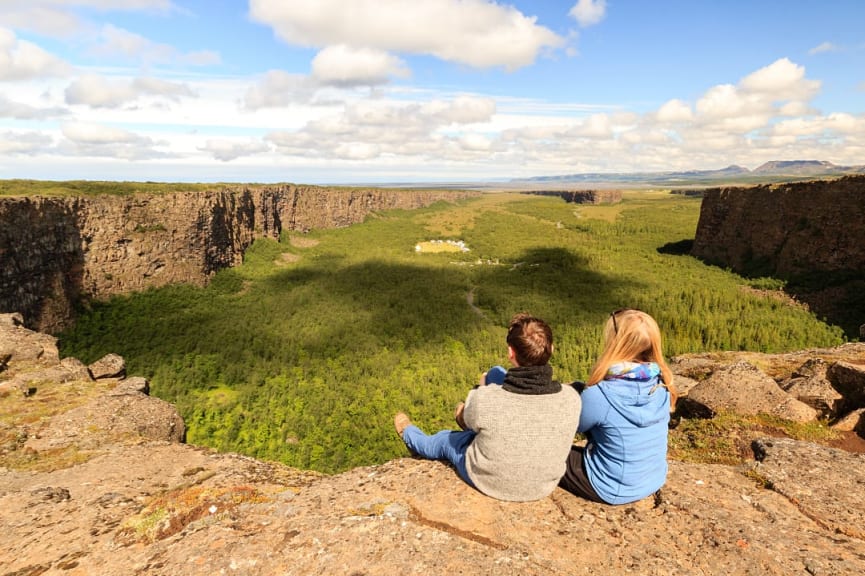
Asbyrgi canyon in Jokulsargljufur National Park, Iceland
Best Months: August • September • October
The best time to visit Iceland as a couple is between August and October, especially when you take into account smaller crowds and more opportunities for secluded escapes come fall.
August is a very popular time in Iceland because of the beautiful trails, access to remote corners of the island like the Westfjords, and the midnight sun, but the fall gives you the trails, alluring secluded corners, and the option to chase the Northern Lights.
You can embrace exclusive experiences that create timeless, intimate memories only possible in Iceland.
Best Time for Seniors
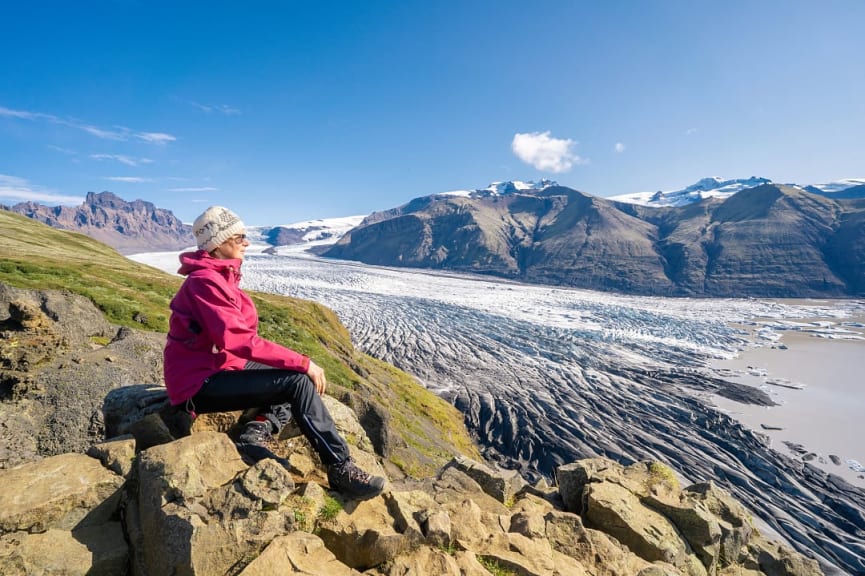
Vatnajokull Glacier in Iceland
Best Months: April • May • September • October
August to September are the best months to visit Iceland for seniors. A senior tour of Iceland can be as active or as relaxing as you’d like, and during the shoulder months of April to May and September to October, you can appreciate the best scenery at your pace.
Whether eager to witness the Northern Lights, interested in touring the Golden Circle, or eager to visit the remote rural towns, the shoulder season in Iceland can give you the best of summer and winter experiences, with better weather and without the large crowds.
Spring & Summer Activities
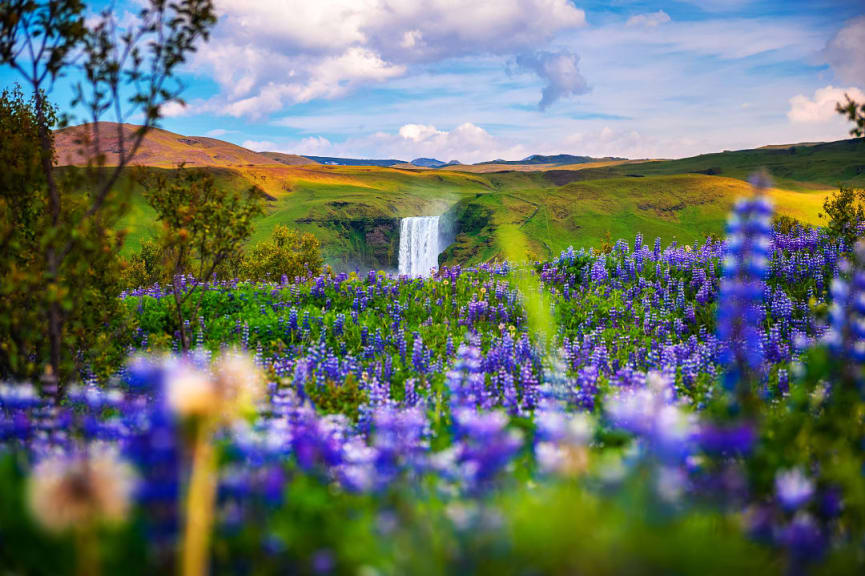
Spring, summer in Iceland
Best Months: May • June • July
May, June, and July are the best months to visit Iceland in spring and summer. Activities that take you into museums or art galleries are possible year-round, but other adventures are much more conditional upon the weather and the accessibility of the landscape.
May, June, and July feature a different image of Iceland, when waterfalls sound like storms and hiking trails weave through blossoming fields. As the weather warms, you can enjoy popular excursions like whale watching, kayaking, girding, horseback riding, hiking, and food tours.
Fall & Winter Activities
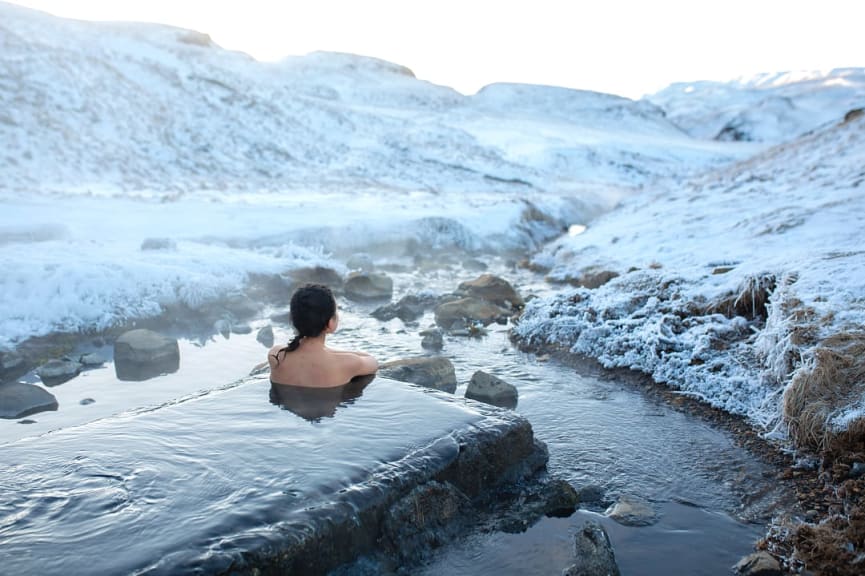
Geothermal bath in Iceland
Best Months: November • December • January
The best months to visit Iceland in fall and winter are between November and January. The weather is crisp and chilly, but provides access to unique and unparalleled natural beauty, from the Northern Lights to ice caves.
Fall and winter in Iceland give you access to dog-sledding and skiing, glacier hikes and snowboarding, with unquestionable connections to authentic culture across the island. Popular and possible excursions in Iceland’s winter and fall include ice caving, geothermal baths, glacier hikes, and the Northern Lights.
Book for the Best Time to Visit Iceland

Moss covered lava field in Iceland
Iceland is legendary for its natural beauty, from the wildlife to glacial lakes, pristine fjords to volcanic peaks. Knowing what things to do and the experiences you want to have will help you understand the best time to visit Iceland. Our Iceland travel guide has information to help you craft your perfect trip.
You can also find more inspiration with our Iceland tours and vacations.
Life-Enriching Travel Designed Just for You
- 1
Trips curated by the world’s top destination experts
- 2
Concierge-level service leading up to and during your trip
- 3
Unique, exclusive experiences and insider access
